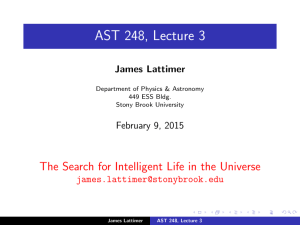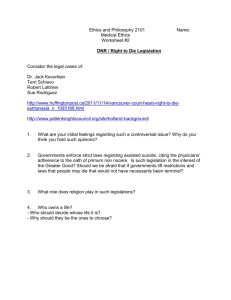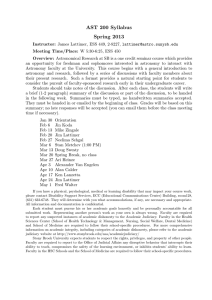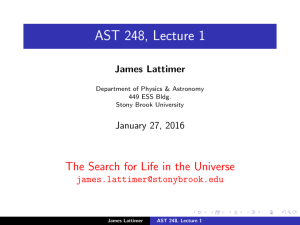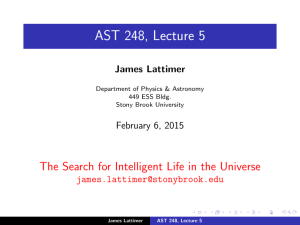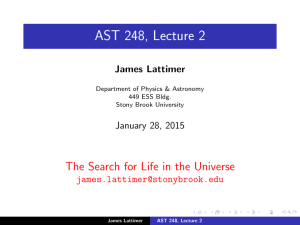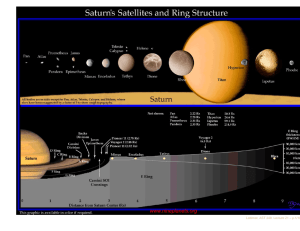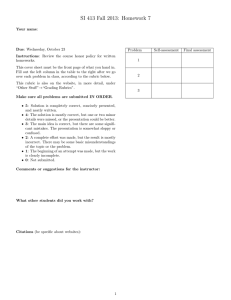AST 248, Lecture 7 James Lattimer March 7, 2016
advertisement
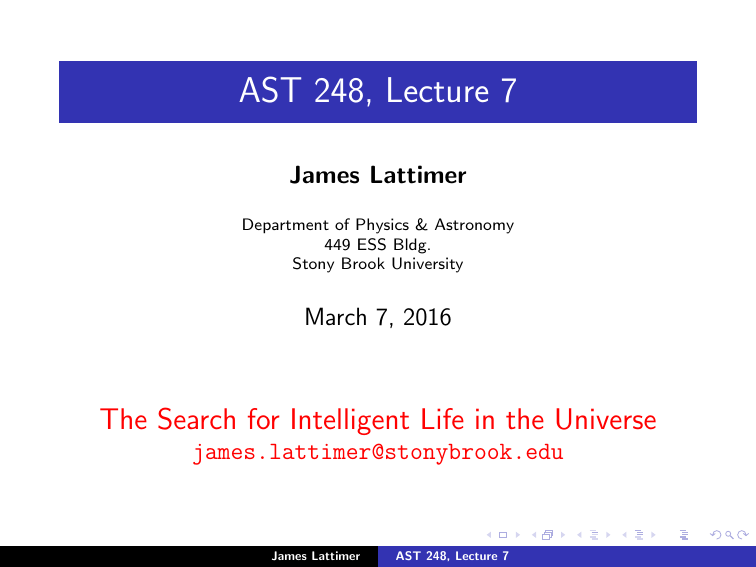
AST 248, Lecture 7 James Lattimer Department of Physics & Astronomy 449 ESS Bldg. Stony Brook University March 7, 2016 The Search for Intelligent Life in the Universe james.lattimer@stonybrook.edu James Lattimer AST 248, Lecture 7 Radioactive Dating Nucleus Decay Product 147 Sm Nd143 87 Rb Sr87 Th232 Pb208 U238 Pb206 40 K Ar40 U235 Pb207 I129 Xe129 26 Al Mg26 Cl36 Ar36 81 Kr Br81 C14 N14 H3 (tritium) He3 Half Life 106 Gyr 48.8 Gyr 14.4 Gyr 4.47 Gyr 1.25 Gyr 0.70 Gyr 15.7 Myr 717,000 yr 301,000 yr 210,000 yr 5730 yr 12.43 yr James Lattimer AST 248, Lecture 7 Example • Sample contains three minerals A, B, C. • Minerals have different chemical abundances and different • • • • • Rb/Sr ratios. Sr87 and Sr86 are stable, Rb87 is radioactive. When the rock solidified, the isotopic ratios of each mineral had equal values of Sr87 /Sr86 as per line “Then” For each decay of Rb87 , a Sr87 nucleus is produced, so the points move in a 45◦ northwesterly direction as time proceeds. Today, the isotopic ratios of each mineral lie on line “Now”. The older the sample, the larger the angle θ becomes: tan θ = t/t1/2 The angle θ is 45◦ after 1 half life when t = t1/2 . James Lattimer AST 248, Lecture 7 Radioactivity in our Lives Radioactivity in nature has three components: Primordial from before the creation of the Earth Cosmogenic produced by cosmic rays Artificial due to human activity Source Dose (USGS) mrem/yr Inhaled (Mostly Radon 200 Other ingested 39 Terrestrial radiation 28 Cosmic radiation 27 Cosmogenic 1 Artificial (medical) 50 Artificial (consumer products) 9 Artificial (coal + nuclear) 1 Total 355 A rem measures the equivalent dose and is equal to the absorption of 100 erg per g of material times a quality factor that depends on the radiation At an altitude of 1 mile, add 27 mrem to total On the Colorado Plateau, add 63 mrem to total Add 1 mrem for each 1000 miles traveled by jet Add 7 mrem if you live in a stone, brick or concrete building Add 1 mrem if you watch too much TV James Lattimer AST 248, Lecture 7 Carbon Dating • C14 originally on the Earth has long since decayed. earthsci.org/fossils/geotime/radate/radate.html • Cosmic rays bombard N nuclei in atmosphere at a steady rate, converting some of them to C14 . • Rate of production by cosmic rays balances rate of decay, building up a steady-state abundance of C14 • The abundances of C isotopes: C12 - 98.89%, C13 - 1.11% and C14 - 0.00000000010% Arnold & Libby (1949) • C12 /C14 = 1 trillion: This is the ratio found in living tissue • Dead tissue has loss of C14 by radioactive decay: C14 (t) = C14 (0)e −t/8266yr James Lattimer AST 248, Lecture 7 Nuclear Hysteria and Irrational Fears Closing of nuclear accelerator at Brookhaven National Lab in 1997 due to small tritium leak – equivalent to amount used in exit signs. • Loss of medical research accelerator use and user fees • Clean-up cost was millions of dollars • Tritium radiation levels were lower than federal standards (4 mrem/yr), would have decayed before reaching groundwater. • Even if drunk, tritium is rapidly evacuated from the body on timescales much less than decay times. • Clean-up was forced by political pressure from several environmental and anti-lab groups. I Continued reliance on coal (56%) rather than nuclear (18%) power CO2 emission: Coal 2 billion tons/year, same as 300 million autos. Nuclear: 0. Pollution: Coal burning releases 64% SO2 , 26% nitrous oxides (contribute to ozone loss), 33% mercury, plus arsenic, cadmium, chlorine, lead, titanium, etc. Radiation: Coal burning effectively emits about 100 times more radioactivity (as particulate U, Th, K, etc., in exhaust) than nuclear, per unit of power generated. I James Lattimer AST 248, Lecture 7 Radiation: Most radioactivity from coal is vented permanently into atmosphere rather than isolated as a solid. Mining uranium actually decreases future radon exposure: 1 nuclear plant saves 200 lives/year this way. Radiation exposure: Living next to a nuclear plant or 1 year = 1/50 radiation of dental X-ray or transcontinental plane trip. Living next to a coal plant is much worse. It has never been shown that incremental exposure to radiation is harmful. Energy equivalents: The energy content of nuclear fuel released in coal combustion is greater than the energy content of the coal consumed! Mining accidents: 100/yr coal deaths in US, over 5000/yr worldwide; nuclear less than 10/yr worldwide. Waste: Solid waste has much smaller volume; reprocessed wastes need be isolated for only 600 years until radiation levels fall below those of initial fuel, about 1% of its peak radioactivity. James Lattimer AST 248, Lecture 7 Fuel costs: Coal is 3 to 4 times as expensive as nuclear fuel, and oil and natural gas are 4 times more expensive still. However, capital construction costs for nuclear plants are higher, mostly because of strict regulations. Overall, including construction and decommissioning costs, coal ends up being twice as expensive. Accidents: Chernoby-style events cannot occur in Western-designed plants. Chernobyl led to thyroid cancer in about 1000 children and several cancer-related deaths so far, but most of these could have been avoided due to lack of prompt response (i.e., making iodine tablets available) by the government. Three Mile Island accident has led to no provable cancers due to Western-designed containment. Terrorism: In last 20 years, 1 million Africans have been killed by machete; car bombs kill thousands per year; firearms kill 30,000/yr in US; nuclear – 0 so far. James Lattimer AST 248, Lecture 7 From TIME Dec 4, 2006 Centers for Disease Control and Prevention James Lattimer AST 248, Lecture 7 Why Risk Assessment is Difficult The Dread Factor Humans don’t treat all death as being created equal. Fear is increased with pain and suffering optential. This leads to “probability neglect”. A slight increase in cancer rate compared to automobile crashes; AIDS compared to heart disease. We also dread catastrophic risks: e.g., terrorism vs. climate change. Unfamiliar Risks Unfamiliar risks are scarier than familiar ones. But repeated events lead to “habituation”, which lessens the response. The Illusion of Control Driving vs. flying. The so-called 9/11 effect: 1000 more highway fatalities occurred between October and December 2001 than the year before, 30% more fatalities than occurred on 9/11 itself. Risk that Confers Pleasure Drinking, risky sex, recreational drugs, cigarettes, ice cream. Flawed Comparisons Specificity: Prefer “saving 98% of 150 people” compared to “saving 150 people”. Greater risk from “drowning in bathtub” than “mad cow disease”: true, but comparing apples and oranges. Preventing 1% risk of terrorist attack in US (with ¡1000 casualties) was used to justify a war in Iraq that had 100% chance of tens of thousands of casualties. James Lattimer AST 248, Lecture 7 Types of Rocks Igneous – Rocks formed from liquids or other rocks by melting I Basalt – dark, dense igneous rock with high concentrations of heavy elements such as Fe- and Mg-based silicates I Granite - light, less dense igneous rock composed largely of quartz (SiO) and feldspar (light silicates) Metamorphic – Rocks structurally or chemically transformed by high pressure or temperature, but not enough to melt it Sedimentary – Rocks made from gradual compression of sediments (sand, silt, eroded materials) at the bottom of oceans, seas and swamps, contain large concentrations of Ca carbonates. Marked by distinct layers or strata. I Limestone I Shale I Chalk Rocks can change from one type to another. Minerals are individual crystals, with a specific chemical composition, of rocky material. Rocks are formed from an assemblage of minerals. James Lattimer AST 248, Lecture 7 Geologic Time Chart First multicellular organisms Sexual reproduction Oldest fossils of eucaryotes ⇒ Idaho Museum of Natural History Mammals Dinosaurs ⇒ Oxidizing atmosphere Cell specialization/eucaryotes Reducing atmosphere Oldest fossils Oldest evidence for life Oldest rocks Late heavy bombardment Oldest zircons Earth forms Oldest meteorites James Lattimer AST 248, Lecture 7 The Early Earth and Environs I I I I I I I I Solar System forms, 4.568 Gyrs ago. Earth formed from accretion of rocky material beginning 4.558 Gyrs ago. It was too small and warm to capture or retain significant gas. Towards the end of accretion, smaller planetismals (meteorites and comets) from outer solar system introduced volatile materials. Additional gases produced by the large impact that triggered the formation of the Moon (oldest lunar rocks are 4.46 Gyrs old) and volcanic outgassing. Lithium isotopic analysis of oldest zircons (age: 4.35 Gyr) indicate oceans existed by 4.3 Gyrs ago. Oldest bulk rocks are 3.96 Gyrs old; some evidence for even older rocks. Early atmospheric composition was dominated by CO2 . After a period of relative quiescence, an episode of Late Heavy Bombardment (LHB) occurred from 4.1 - 3.8 Gyr ago. I I I I I Lunar mare regions date to 3.9 Gyr ago, long after lunar tectonics cease. The oldest martian crater date similarly. Thought to be triggered by migration of Jupiter into closer solar orbit. Suggests that a series of sterilizing impacts repeatedly destroyed the atmosphere, oceans, and/or life. Differentiation leads to formation of Earth’s core and magnetic field. James Lattimer AST 248, Lecture 7 Evidence for Asteroid – LHB connection James Lattimer AST 248, Lecture 7 Earliest Geologic Records of Life Microfossils and Chemofossils I 4.1 Gyrs (Jack Hills, Western Australia) chemofossils – flecks of graphite in zircon crystals I 3.85 Gyrs (Akilia Island, Greenland) chemofossils I 3.4–3.5 Gyrs (North Pole and Onverwacht, Australia) the so-called Warawoona finds; bacteria-like microfossils apparently fossilized cells of filamentous organisms, not universally accepted I 3.43 Gyrs oldest fossilized remnants of single-celled cyanobacterial microbial mats (stromatolites) I 3.2 Gyrs (Fig Tree, S. Africa) I 2.6–2.7 Gyrs (Eastern Transvaal, S. Africa) fossilized remnants of microbial mats (stromatolites), identified by relative abundances of H, C, N, O and P; oldest evidence of life on land, requiring ozone layer and O2 in atmosphere. James Lattimer AST 248, Lecture 7 Carbon Isotopes Isotopic evidence (chemofossils) may be more reliable indicators than shape (microfossils), but are still controversial. There are non-living ways of increasing the C12 /C13 ratio. These include, for example, some rare types of meteorites have higher ratios than normal, and the so-called Fischer-Tropsch reactions, in which carbon, oxygen, and hydrogen react with a catalyst like iron to form methane and other hydrocarbons. Such reactions probably occurred near hydrothermal vents in Jack Hills zircon crystal the Hadean Eon. C12 /C13 = 120 in fossilized material, same as in present-day living matter. C12 /C13 = 99 in non-living terrestrial matter. James Lattimer AST 248, Lecture 7 James Lattimer AST 248, Lecture 7 Schopf et al. Nature (2002) James Lattimer AST 248, Lecture 7 Stromatolites Primitive life used anaerobic photosynthesis: 12H2 S + 6CO2 → C6 H12 O6 + 12S + 6H2 O As H2 S abundance dwindled, evolution of aerobic photosynthesis: 6CO2 + 6H2 O → C6 H12 O6 + 6O2 Stromatolites are sedimentary deposits from aerobic blue-green algae Age: 2–2.4 Byrs mostly, but up to 3.1 Byrs Aerobic photosynthesis releases free oxygen, transforming atmosphere from reducing (oxygen-poor) to oxidizing (oxygen-rich) Shark Bay, Western Australia James Lattimer AST 248, Lecture 7 Inorganic Rocks Iron has two chemical states in minerals: I Ferrous: Fe++ , dissolves in water I Ferric: Fe+++ , precipitates Formed alternating layers of ferrous and ferric iron: banded-iron formations. Mark reducing/oxidizing transition in atmosphere, 2.4–2.7 Byrs ago. Iron dissolved in oceans slowed the transition preventing an “Oxygen Catastrope”, the oxygen poisoning of life. Allowed the evolution of aerobic respiration. Even today, organisms ‘remember’ anaerobic respiration when cells are starved of oxygen. Andrew Karwath James Lattimer AST 248, Lecture 7
